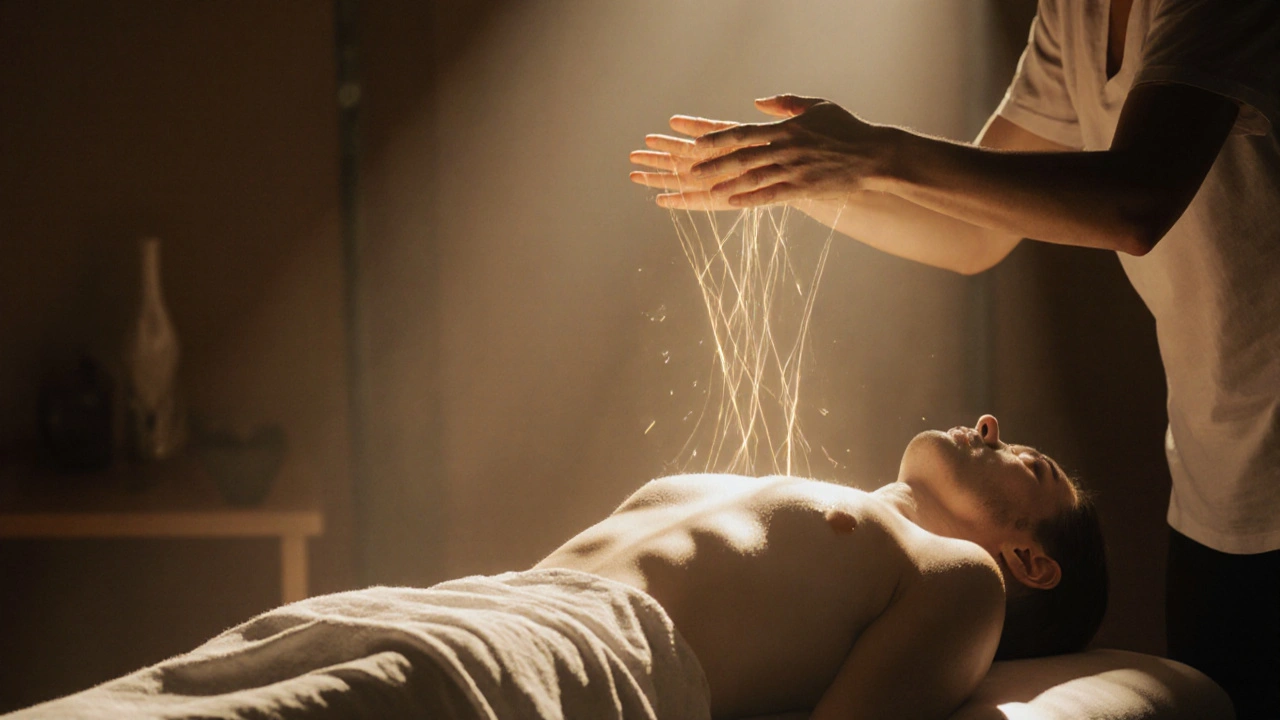How Polarity Therapy Helps Manage Stress Naturally
 Nov, 15 2025
Nov, 15 2025
Stress Level Assessment Tool
This assessment helps you understand your stress level and whether polarity therapy might be beneficial for you. The tool asks 6 simple questions about your daily stress experiences. Take a moment to reflect honestly.
How is your stress affecting you?
When stress becomes constant-when your shoulders never relax, your mind won’t shut off, and even deep breathing feels like a chore-it’s not just emotional. It’s physical. Your body holds tension like a coiled spring, and traditional methods like meditation or exercise don’t always cut it. That’s where polarity therapy comes in. It doesn’t promise miracles, but for many people struggling with chronic stress, it offers something rare: a way to feel grounded again without drugs or deep talk therapy.
What Is Polarity Therapy?
Polarity therapy is a form of energy healing developed in the 1940s by Dr. Randolph Stone, a chiropractor, osteopath, and naturopath. He combined ancient healing systems-Ayurveda from India, Traditional Chinese Medicine, and Western energy concepts-into one system focused on balancing the body’s natural energy fields. At its core, polarity therapy believes that life energy flows through the body like electricity, and when this flow gets blocked or imbalanced, stress, pain, and illness follow.
Unlike acupuncture, which uses needles, or Reiki, which relies on hand placement alone, polarity therapy uses a mix of gentle touch, movement, stretching, and verbal guidance. Practitioners classify energy into three poles: positive (head), negative (feet), and neutral (torso). The goal? To restore smooth, balanced movement between these poles so energy can flow freely again.
It sounds abstract, but the effects are physical. People who’ve tried it describe it as feeling like a heavy coat was suddenly taken off. Your breathing deepens. Your jaw unclenches. You realize you hadn’t taken a full breath in days.
How Polarity Therapy Reduces Stress
Stress isn’t just in your head-it’s in your muscles, your nervous system, your connective tissues. Chronic stress keeps your sympathetic nervous system (the ‘fight or flight’ mode) stuck on. Polarity therapy works by activating the parasympathetic nervous system, the part that says, ‘It’s safe to relax now.’
Here’s how it happens in a typical session:
- The practitioner begins with light touch along the spine, head, and limbs, sensing areas of tension or energy blockage.
- They use specific hand movements-sometimes holding, sometimes gliding-to encourage energy to move from congested areas to open ones.
- You might be guided through gentle stretches or breathing exercises that help release physical holding patterns.
- Some practitioners incorporate sound (like toning or humming) or color visualization to support emotional release.
It’s not massage. You don’t get kneaded. It’s not chiropractic. You don’t get popped. It’s more like being gently rewired.
A 2020 study published in the Journal of Alternative and Complementary Medicine followed 48 adults with high stress levels who received weekly polarity sessions for eight weeks. Participants reported a 42% average reduction in perceived stress, measured by the Perceived Stress Scale. More importantly, 76% said they slept better, and 68% noticed they reacted less sharply to daily frustrations.
What Happens in Your Body During a Session?
Underneath the energy talk, there’s real biology at work. Polarity therapy influences the autonomic nervous system, which controls heart rate, digestion, and stress responses. The light, rhythmic touch stimulates the vagus nerve-the main nerve connecting brain to body-which triggers a calming cascade: lower cortisol, slower heart rate, relaxed muscles.
Think of your body like a garden. Stress is the drought. Polarity therapy is the slow, steady watering. It doesn’t flood the soil. It doesn’t force growth. It just restores the natural flow so your body can heal itself.
Many people report feeling warmth, tingling, or subtle pulsing during sessions. These aren’t placebo effects-they’re signs of increased circulation and nerve sensitivity returning to normal. In one case, a Toronto-based teacher with work-related burnout described feeling a ‘wave of calm’ move from her feet up to her head after just 20 minutes. She hadn’t felt that since before her mother passed away, five years earlier.
Who Benefits Most From Polarity Therapy?
It’s not for everyone, but it’s especially helpful for people who:
- Feel emotionally drained but can’t pinpoint why
- Have chronic muscle tension-especially in the neck, shoulders, or jaw
- Struggle with anxiety that doesn’t respond to talk therapy
- Are sensitive to touch or find traditional massage too intense
- Prefer non-invasive, drug-free approaches to wellness
It’s also used by people recovering from trauma, dealing with long-term illness, or transitioning through major life changes like divorce, job loss, or retirement. It doesn’t erase the cause of stress, but it gives your body space to recover from its effects.
One client, a nurse working ICU shifts, started polarity therapy after three years of insomnia and panic attacks. She didn’t quit her job. She didn’t change her routine. But after six sessions, she said, ‘I finally feel like I’m living in my own skin again.’

What to Expect in Your First Session
Your first session usually lasts 60 to 90 minutes. You’ll lie fully clothed on a massage table. No oils, no undressing. The practitioner will ask about your stress triggers, sleep patterns, and any physical discomfort. Then they’ll begin with a quiet, hands-on assessment.
Some people feel immediate relief. Others feel nothing at first-and that’s okay. Polarity therapy isn’t about instant fixes. It’s about gradual recalibration. Most practitioners recommend at least three to five sessions spaced a week apart to notice lasting change.
After a session, you might feel: relaxed, slightly tired, emotionally sensitive, or oddly energized. Drink water. Avoid caffeine or heavy meals for a few hours. Give yourself space to integrate. It’s like rebooting your system.
Polarity Therapy vs. Other Energy Therapies
People often confuse polarity therapy with Reiki, acupuncture, or therapeutic touch. Here’s how it’s different:
| Therapy | Method | Touch Level | Session Focus | Typical Duration |
|---|---|---|---|---|
| Polarity Therapy | Energy balancing with touch, movement, breathing | Light to moderate | Whole-body energy flow | 60-90 minutes |
| Reiki | Hand placement without movement | Light, non-contact | Chakra alignment | 45-75 minutes |
| Acupuncture | Needles inserted at specific points | Deep, invasive | Meridian channel clearing | 30-60 minutes |
| Therapeutic Touch | Hands moved over body without contact | No contact | Energy field rebalancing | 20-40 minutes |
Polarity therapy stands out because it includes movement and dialogue. You’re not just a passive recipient-you’re guided to participate in your own healing. That active component makes it more effective for people who’ve tried other energy therapies and felt like something was missing.
Is Polarity Therapy Safe?
Yes. It’s non-invasive, gentle, and has no known side effects when done by a trained practitioner. It’s safe for pregnant women, children, and people with chronic conditions. It doesn’t interfere with medications or other treatments.
But not everyone is qualified. Look for practitioners certified by the Polarity Energy Therapy Association or the International Polarity Association. These organizations require 500+ hours of training, including anatomy, ethics, and supervised practice. Avoid anyone who claims to ‘cure’ diseases or makes grand promises. Polarity therapy supports healing-it doesn’t replace medical care.

Can You Do Polarity Therapy at Home?
You can’t fully replicate a professional session alone, but you can use simple polarity principles to reduce daily stress:
- Place one hand on your forehead (positive pole) and the other on your lower belly (negative pole) for five minutes while breathing slowly.
- Walk barefoot on grass or sand for 10 minutes a day-this grounds your energy.
- Stretch gently in the morning, focusing on releasing tension from your jaw, shoulders, and hips.
- End your day by lying down and imagining energy flowing from your head to your feet like a river.
These aren’t magic tricks. They’re small acts of reconnection. Over time, they train your body to return to calm faster.
Where to Find a Practitioner
In Canada, polarity therapy is offered in wellness centers, holistic clinics, and some naturopathic offices. In Toronto, places like the Toronto Holistic Wellness Centre and BodyMind Healing Studio have certified practitioners. Most charge between $80 and $120 per session. Some extended health plans cover it under ‘alternative therapies’-check your policy.
Don’t rush into the first practitioner you find. Schedule a 15-minute phone chat. Ask: ‘How do you approach stress?’ ‘What do you expect me to feel?’ ‘How many sessions do you recommend?’ Trust your gut. If you don’t feel safe or heard, keep looking.
Real Results, Not Hype
Polarity therapy won’t fix your job, your finances, or your relationships. But it can help you stop carrying them like weights. It gives your nervous system a reset button. For people drowning in stress, that’s not just helpful-it’s life-changing.
One woman in Hamilton told me she started polarity therapy after her husband left. She didn’t cry during sessions. She didn’t talk about him. But after four weeks, she woke up one morning and realized she hadn’t thought about him for two days. Not because she’d moved on-but because she finally felt like herself again. That’s the quiet power of polarity therapy. It doesn’t fix your story. It helps you live in your body while you write the next chapter.
Can polarity therapy help with anxiety?
Yes. Many people with anxiety find that polarity therapy helps calm their nervous system more effectively than meditation alone. The gentle touch and energy balancing reduce physical tension that often fuels anxious thoughts. Studies show it lowers cortisol levels and improves heart rate variability, both key markers of anxiety reduction.
How many sessions do I need to see results?
Most people notice a shift after three to five sessions, especially if they’re dealing with chronic stress. For deeper issues like trauma or long-term burnout, six to ten sessions spaced weekly are common. The goal isn’t to ‘finish’ therapy but to give your body time to relearn how to relax.
Is polarity therapy covered by insurance in Canada?
Some extended health plans in Canada cover polarity therapy under ‘alternative therapies’ or ‘naturopathic services,’ but coverage varies. You’ll need a practitioner certified by a recognized association like the International Polarity Association. Always check with your provider before booking.
Can polarity therapy replace medication for stress?
No. Polarity therapy is a complementary practice, not a replacement for medical treatment. If you’re on medication for anxiety, depression, or another condition, continue taking it as prescribed. Polarity therapy can support your treatment by helping your body respond better to stress, but it doesn’t alter brain chemistry the way pharmaceuticals do.
Does polarity therapy hurt?
No. It’s designed to be gentle. Some people feel mild discomfort if there’s a deep energy block, but practitioners adjust pressure to your comfort level. You should never feel pain. If you do, speak up immediately. A good practitioner will never push through resistance.
If you’ve tried everything else and still feel like you’re running on empty, polarity therapy might be the quiet reset you’ve been looking for. Not because it’s new or trendy-but because it works with your body, not against it.
